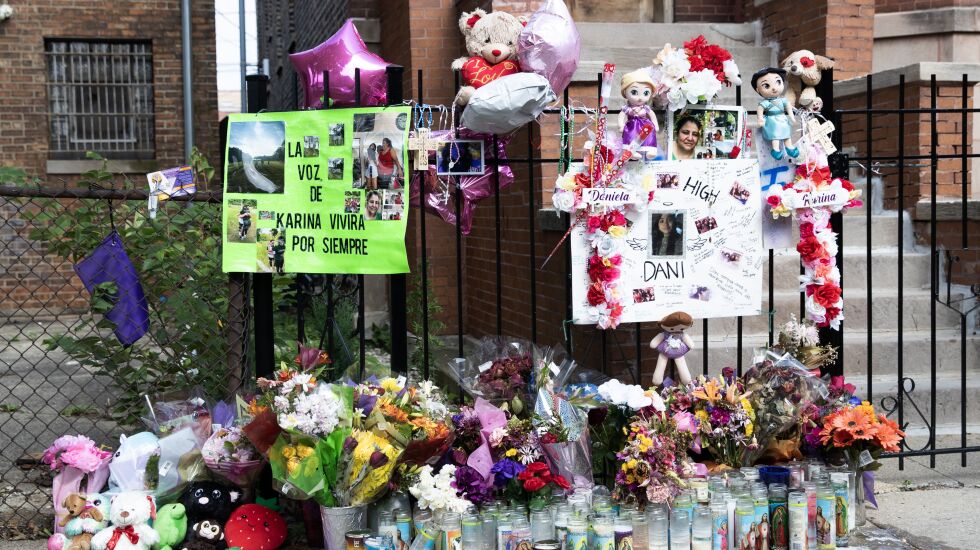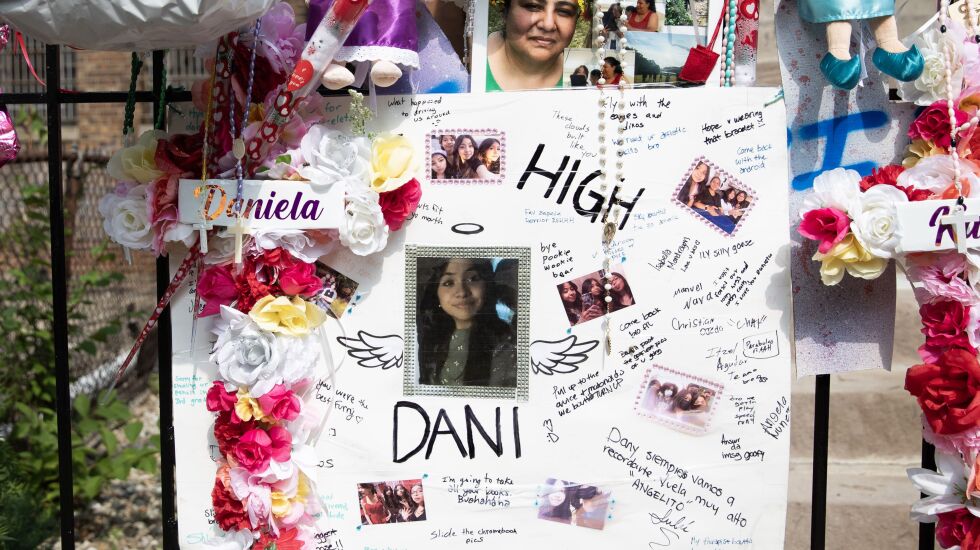
Two weeks before Karina Gonzalez was fatally shot in her Little Village home, she walked into the Ogden district police station and said her husband had threatened to kill her.
“You do not know who I am,” Jose Alvarez had yelled to his wife, according to her complaint, which also noted Alvarez had a gun in the home.
In the days that followed, Gonzalez was granted an order of protection against Alvarez banning him from their home. Chicago police filed a clear and present danger report on him, and Illinois State Police revoked his firearm owners identification card.
Yet Alvarez was still in the home and still had his Glock 9mm handgun on July 3 when prosecutors say he fatally shot his wife and 15-year-old daughter and wounded his 18-year-old son.
Under current state law, there is no clear process for removing a gun after an order of protection has been issued, according to domestic violence prevention advocates. The law also does not dictate how quickly it must be done.
“There’s no accountability,” said Amanda Pyron, executive director of the Network, a collection of domestic violence prevention groups. “While you know a FOID card is supposed to be revoked, and in this case was revoked, that does nothing to affect a person’s ability to own their firearms.”
A bill in the General Assembly would give police the authority to immediately remove a gun after a protection order is issued and would give them 48 hours to do it.
“If we had passed it a couple of years ago, countless lives would have been saved,” Rep. Maura Hirschauer, lead sponsor of the bill, told the Sun-Times. “Every moment we waste in passing it is a threat to the safety of survivors and their families.”
‘Clear and present danger’
A day after Gonzalez reported her husband’s threats to police, she went to court and was granted an order of protection against him. She cited his drinking, drug use and threatening behavior. The order automatically revoked his FOID card.
The next day, Chicago police responded to a “domestic disturbance” call at the home, but there’s no indication they were aware of the order or had run his name to check on outstanding warrants and orders.
The order had been entered into the Illinois Law Enforcement Agencies Data System the day before and would have appeared had the officers checked, according to state police.
Alvarez met the officers at his window, complained his wife wanted him to be a “hit man” and mentioned he had a FOID card and a gun.
The officers noticed the gun was within his reach and said they began to position themselves “for safety” as Alvarez began talking about “multiple subjects not regarding the nature of his call,” according to a police report.
Alvarez gave the officers his FOID card, and when they tried to give it back, he shut the window, they said. The officers said they filed a clear and present danger report, which is supposed to be sent to state police.
State police are supposed to review a clear and present danger report within 24 hours, revoke the FOID card and notify local law enforcement, under state law.
But state police say they never received a report.
The next day, June 23, Cook County sheriff’s deputies went to Alvarez’s home to officially serve the order of protection, but he was not home. The same day, state police matched the order of protection with Alvarez’s FOID card. On June 24, they notified Chicago police and the Cook County sheriff by email.
Neither Chicago police nor the Cook County sheriff’s office could confirm they received the notification. The Sun-Times could find no record of anyone going to the home to remove the gun.
Eight days later, Gonzalez and her daughter were dead.
The Chicago Police Department would not answer specific questions about the officers’ actions but released a statement saying: “We are reviewing every aspect of this tragic case. We deeply care about the safety and well-being of victims who have experienced domestic violence and are evaluating our policies and procedures related to these incidents.”
‘Leaving doesn’t always equal safety’
Law enforcement agencies were unable to provide a clear process or timeline for seizing a gun once a FOID card has been revoked.
The state police have the primary responsibility, under state law, but they heavily rely on local police and sheriff’s deputies to go to the home and remove a gun.
In Cook County, there are nearly 30,000 outstanding cases of people whose FOID cards have been revoked but who likely still have guns.
In domestic violence cases, the presence of a gun in the home increases the risk of a homicide by 500%, according to a 2022 report from the Network.
“People who use harm will go to any lengths at any time to continue to exert harm or even kill their partners,” said Stephanie Love-Patterson, executive director of Connections for Abused Women and Their Children.
“Leaving doesn’t always equal safety or taking back your power either, even getting an order of protection does not necessarily lead to safety,” she said.
With people who have obtained an order of protection, Love-Patterson said her organization works on safety planning, ensuring their place of work or their children’s schools are aware of the order and able to act if the partner tries to visit.
“It is frustrating to learn that individuals are still being killed, even when they’re trying to do the right thing to protect themselves and their children,” she said.

A bill passed by the Illinois House aims to streamline the process for seizing weapons in cases of domestic violence. When a judge grants an order of protection, a seizure order would have to accompany it.
It would give an officer or a deputy the authority to seize guns when serving an order of protection, according to the bill’s backers. The bill would give law enforcement agencies 48 hours to serve the order and seize any guns.
“Making sure there’s clarity for everyone involved in the chain when the emergency orders are issued, making sure judges know what their responsibility is and that law enforcement clearly know what their responsibility is, will help keep people safe,” Hirschauer said.
The provisions, supported by the Cook County sheriff’s office, were part of a firearm safety package passed by the House in May. It didn’t clear the Senate, but its advocates hope to push it through during the fall veto session.
There are also attempts in Springfield to close a loophole in the order of protection statute that allows people to transfer firearms to family members in the same home. Instead, people served with orders would have to hand their weapons over to law enforcement.
While the larger omnibus firearm bill has received pushback from gun rights groups, Hirschauer is optimistic lawmakers from both sides of the aisle can agree on removing weapons from the hands of abusers.
The Johns Hopkins National Survey of Gun Policy, released last month, found 81% of Americans support prohibiting a person subject to a temporary domestic violence protection order from having a gun for the duration of the order.
Nearly 30,000 outstanding cases
While lawmakers are focused on strengthening state laws, there is still the challenge of enforcing them.
In Cook County alone, there are about 731,000 FOID card holders. Of those, more than 37,000 have been revoked. Of those revoked, 74%, or roughly 27,000, are noncompliant, meaning they likely still have their weapons.
The sheriff’s office said its primary jurisdiction is in unincorporated Cook County but it also helps out in towns and the city of Chicago. “The sheriff’s office started doing this work a decade ago because no one – including ISP – was doing it,” the office said in a statement. “For years we remained the only agency doing any meaningful work on this issue.”
During a public hearing in June 2022, Cook County sheriff’s police told legislators they did not have the manpower or money to handle all the revoked FOID cases.
“We were simply describing the problem that all local law enforcement face – there are not enough people or funds available to eliminate this backlog,” the sheriff’s office said. “While it’s true that we don’t have the manpower or money to handle all of the backlog in Cook County, the fact remains that this is ultimately the responsibility of the Illinois State Police.”
For whatever reason, advocates of domestic violence prevention say the system failed Gonzalez and her family.
Gonzalez and her two children left home June 20 but returned June 26 after Alvarez agreed to go to rehab, according to prosecutors.
On July 3, Alvarez began accusing his wife of cheating on him, as he had done in the past. Gonzalez told him to stop and joined her children on a couch in the living room, according to prosecutors.
Alvarez’s son told him to “stop or he would call 911” and walked toward his room, prosecutors said. Alvarez then rushed past him and grabbed his gun, prosecutors said. He shot Gonzalez and their 15-year-old daughter Daniela, then returned to the dining room and fired under the table where his son was shielding himself with a chair, prosecutors said.
Gonzalez was shot eight times and pronounced dead at the scene. Daniela was shot in her face and forearm and died after being taken to Mount Sinai Hospital, police said. The son was hit in his ankle and ran out of the apartment.
“As disheartening as this story is, and so many stories, we have to keep pushing for the city that we want to see and the safety net that we know survivors deserve,” Pyron said.
The Network operates the Illinois Domestic Violence Hotline, which people can call or text any time of day at 877-863-6338 (877-TO END DV).







